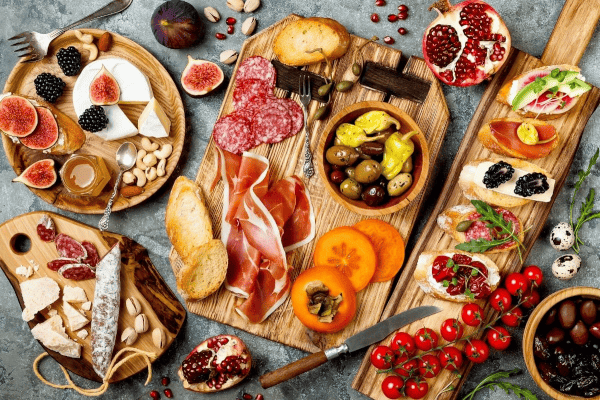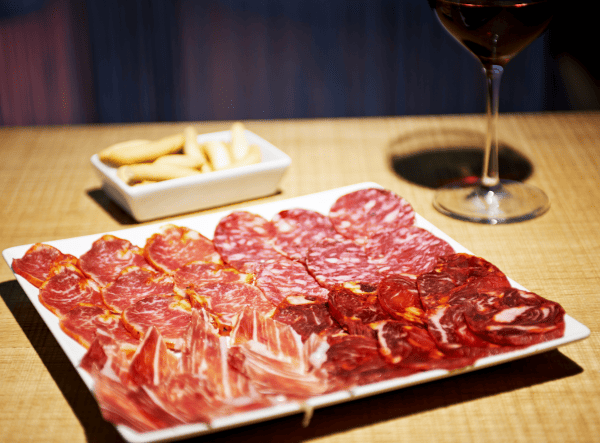El mundo de las tapas en España es inacabable. Hay tantos tipos de tapas como productos gastronómicos y cada región de España tiene sus más conocidas y típicas de acuerdo con su tradición y cultura gastronómicas propias.Como gran productora agraria, ganadera y pesquera, la Península Ibérica tiene la inmensa suerte de contar con las mejores materias primas del mundo, a las que nuestros cocineros, algunos de gran reputación mundial, le sacan el mejor partido elaborando unas tapas gourmet o de autor exquisitas. Sin embargo si hay algo de especial que tienen las tapas, es que mientras el producto sea bueno y de calidad, no es necesario que nos lleve mucho tiempo su elaboración ni que tengan muchos ingredientes. Como dice el dicho, lo bueno, si es breve, es dos veces bueno.
Origen de las tapas
Es harto conocido el gusto y la afición que los españoles tenemos por el tapeo, (o el ir de tapas), tanto es así que se ha convertido en un símbolo de nuestra identidad y principal rasgo de nuestra gastronomía a nivel mundial. Cuando nos visitan los turistas de otros países, en su lista de cosas a hacer, el ir de tapas está entre las primeras sino la primera, y suelen repetir mucho hasta que vuelven de nuevo a sus países. Fuera de nuestras fronteras, no hay restaurante de cocina española que no ofrezca tapas y es que esta afición viene de muy lejos.
Hay varias teorías o versiones sobre el origen de esta maravillosa costumbre. No vamos a mencionarlas todas pero sí las más destacadas y la primera se remonta al S.XIII con el rey Alfonso X “El Sabio” quien ordenó que en los mesones españoles no se sirviese vino sin algo de comida para que este no “se subiese demasiado rápido a la cabeza” y evitar reyertas evitables. Pero en realidad la idea, no fue de él sino de un mesero. Parece ser que el rey en una de sus paradas por el camino, entró en una taberna y el mesero le ofreció una copa de vino y como entraba corriente de aire, tuvo la idea de coger una loncha de jamón y ponerla encima de la copa en forma de tapa, para evitar que entraran cuerpos extraños en la copa del rey. El rey quedó encantado después de comerse la “tapa” de su copa, bebió el vino y luego pidió otro pero con otra “tapa” igual. El resto de miembros de la corte pidieron lo mismo.
Las tapas de Enrique Tomás
Otra explicación popular es que fue una idea que surgió del interés económico de los taberneros que ofrecían un poco de comida salada (precisamente jamón) para dar más sed a los clientes y que siguieran bebiendo y gastando.
Sea como fuere, vemos que el jamón es el origen de la tapa, hablar de tapas es hablar de jamón...con el paso de los siglos esto se convirtió obviamente en un atractivo para los viajeros que a veces tomaban una ruta u otra dependiendo de la fama de sus tapas. Y hoy en día, en el siglo XXI, no sólo son un atractivo, sino que todo cocinero que se precie ha incluido en su carrera profesional las tapas de autor para ser conocido en todo el mundo.
- Pescados (mejillones, calamares, anchoas, boquerones),
- Croquetas variadas
- Diferentes tipos de tortilla
- Las famosas olivas españolas super deliciosas,
- Verduras variadas
- Las increíbles patatas bravas
- Y por supuesto Jamón.
Hay mucho más donde escoger como paella mediterránea, gazpacho andalúz, Chipirones, Pulpo a la gallega, Fideuà, las mejores carnes ibéricas en barbacoa y muchas muchas cosas más como queso Manchego, bocadillos variados y mucho jamón, como no puede ser de otra manera.
Todo hecho por chefs especializados en nuestra cocina española y mediterránea. Además el jamón está presente en todo el local con nuestros expertos cortadores que hacen del corte de jamón un arte culinario.
FAQs
¿QUÉ SON LAS TAPAS?
Aunque imaginamos que poca gente no conoce qué son las tapas, vamos a decribirlas brevemente. Las tapas son pequeñas cantidades de comida que se sirven en los bares para acompañar una bebida. En España es muy común ir de tapas: una tradición que consiste en ir de bar en bar con amigos a comer y a beber (normalmente cerveza o vino).
¿HAY TAPAS GOURMET?
Por supuesto, y tapas de autor. Si la idea original de las tapas fue acompañar una bebida, hoy en día son mucho más en muchos restaurantes, ya que son su razón de ser y tienen carta de vinos especiales para acompañar las tapas. La mayoría de los grandes chefs tienen su propia creación en tapas en función de los productos de temporada y de su creatividad personal.
Por ello, son mucho más que una porción de comida para acompañar una bebida. Hoy en día, son parte de una gastronomía española de alto nivel como lo puede ser cualquier plato refinado. Se pueden comer como aperitivo antes de la comida principal o comer de forma exclusiva a forma de tapas variadas.
¿TODOS LOS RESTAURANTES SIRVEN TAPAS?
En España casi todos los restaurantes tienen una oferta de tapas y fuera de España los restaurantes de cocina española, las convierten en su reclamo más preciado. No obstante, no todos los restaurantes que ofrecen tapas fuera de la Península ibérica, sirven lo que nosotros entendemos por tapas, y por desgracia algunos les dan este nombre a combinados alimenticios más en línea con un “fast food” de baja calidad que si no se conoce bien qué son realmente las tapas, pueden desvirtuar su origen y calidad auténticas.





